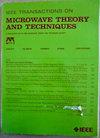Design of RF PAs Using PSO Algorithm With Dynamic Nonlinear Self-Adaptive Hyperparameters
IF 4.1
1区 工程技术
Q2 ENGINEERING, ELECTRICAL & ELECTRONIC
IEEE Transactions on Microwave Theory and Techniques
Pub Date : 2024-12-27
DOI:10.1109/TMTT.2024.3520173
引用次数: 0
Abstract
In this work, a new particle swarm optimization (PSO) method with dynamic nonlinear self-adaptive hyperparameters (DNSHs) (PSO-DNSHs) is proposed for radio frequency (RF) power amplifier (PA) design. The theory and advantages of this method are described and analyzed. Based on the proposed PSO-DNSH method, a multioctave PA and a broadband pseudo-Doherty load-modulation balance amplifier (PD-LMBA) are designed. The multioctave single-ended PA achieves an output power exceeding 40.3 dBm, a drain efficiency greater than 60.9%, and a gain of over 10.3 dB between 0.5 and 3.6 GHz. While the broadband PD-LMBA shows a saturated output power of 41.1–43 dBm, a saturation drain efficiency of 57.7%–77.6%, a 6-dB output power back-off (OBO) DE of 47.3%–64.6%, and a 10-dB OBO DE of 51.2%–68.4%. Compared with other existing PSO-based methods, the results demonstrate that the proposed method not only achieves better performance for both PAs, but also shows faster convergence capability. Modulated signal tests along with the digital predistortion (DPD) are also conducted for both PAs, 20-MHz 5G new radio (NR) signal with 6- and 10-dB peak-to-average power ratios (PAPRs) are used for single-ended PA and PD-LMBA, respectively. Excellent linearity is achieved for both PAs.求助全文
约1分钟内获得全文
求助全文
来源期刊

IEEE Transactions on Microwave Theory and Techniques
工程技术-工程:电子与电气
CiteScore
8.60
自引率
18.60%
发文量
486
审稿时长
6 months
期刊介绍:
The IEEE Transactions on Microwave Theory and Techniques focuses on that part of engineering and theory associated with microwave/millimeter-wave components, devices, circuits, and systems involving the generation, modulation, demodulation, control, transmission, and detection of microwave signals. This includes scientific, technical, and industrial, activities. Microwave theory and techniques relates to electromagnetic waves usually in the frequency region between a few MHz and a THz; other spectral regions and wave types are included within the scope of the Society whenever basic microwave theory and techniques can yield useful results. Generally, this occurs in the theory of wave propagation in structures with dimensions comparable to a wavelength, and in the related techniques for analysis and design.
 求助内容:
求助内容: 应助结果提醒方式:
应助结果提醒方式:


